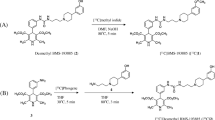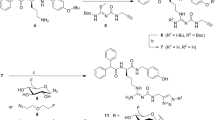Abstract
Neuropeptide Y (NPY) Y1 receptors are overexpressed in human breast carcinomas. They also have important functional roles in breast tumour growth and metastasis. This study investigates the synthesis of 15 truncated NPY analogues as models for Y1 receptor specific radiopharmaceuticals, using competition radioreceptor binding assays from brain tissue homogenates from Y2Y4-double knockout mice. These peptides are based on the previously reported BVD15 scaffold. Different measures to improve Y1 affinity and plasma metabolic stability were investigated. Extending from the previously reported [Lys(DOTA)4]BVD15 analogue, it was found that lysine4 is capable of tolerating various modifications, including prosthetic groups and other bifunctional chelators, but also that [Lys4]BVD15 has improved Y1 affinity, relative to BVD15 itself. Substitution of lysine4 for side chain shortened analogues retains Y1 receptor affinity of the analogues. Furthermore, modifications at the N-terminal isoleucine resulted in dramatic reduction of Y1 affinity.


Similar content being viewed by others
Abbreviations
- Ac:
-
Acetyl
- Arg:
-
Arginine
- Asn:
-
Asparagine
- BFC:
-
Bifunctional chelator
- Bn:
-
Benzyl
- Dab:
-
2,4-Diaminobutyric acid
- Dap:
-
2,3-Diaminopropionic acid
- DIC:
-
N,N-Diisopropylcarbodiimide
- DIPEA:
-
N,N-Diisopropylethylamine
- DMB:
-
1,3-Dimethoxybenzene
- DMF:
-
N,N-Dimethylformamide
- DOTA:
-
1,4,7,10-Tetraazacyclododecanetetraacetic acid
- FBz:
-
4-Fluorobenzoic acid
- Fmoc:
-
Fluorenylmethyloxycarbonyl
- HOBt:
-
N-Hydroxybenzotriazole
- HCTU:
-
O-(6-Chloro-1-hydrocibenzotriazol-1-yl)-1,1,3,3-tetramethyluronium hexafluorophosphate
- HFIP:
-
1,1,1,3,3,3-Hexafluoroisopropanol
- IBz:
-
4-Iodobenzoic acid
- Ile:
-
Isoleucine
- Leu:
-
Leucine
- Lys:
-
Lysine
- NCS:
-
Isothiocyanate
- NOTA:
-
1,4,7-Triazacyclononanetriacetic acid
- NPY:
-
Neuropeptide Y
- Orn:
-
Ornithine
- Pro:
-
Proline
- RP-HPLC:
-
Reverse phase high performance liquid chromatography
- TFA:
-
Trifluoroacetic acid
- TIPS:
-
Triisopropylsilane
- Tyr:
-
Tyrosine
References
Balasubramaniam A, Dhawan VC, Mullins DE et al (2001) Highly selective and potent neuropeptide Y (NPY) Y1 receptor antagonists based on [Pro30, Tyr32, Leu34] NPY(28–36)-NH2 (BW1911U90). J Med Chem 44:1479–1482
Beck-Sickinger AG, Jung G (1995) Structure–activity relationships of neuropeptide Y analogues with respect to Y1 and Y2 receptors. Biopolymers 37:123–142
Beck-Sickinger AG, Weland HA, Wittneben H, Willimz K-D, Rudolf K, Jung G (1994) Complete l-alanine scan of neuropeptide Y reveals ligands binding to Y1 and Y2 receptors with distinguished conformations. Eur J Biochem 225:947–958
Bishop J, Coleman M, Cooke B et al (2004) Breast fine needle aspiration cytology and core biopsy: a guide for practice, 1st edn. National Breast Cancer Centre, Camperdown
Blomqvist AG, Herzog H (1998) Y-receptor subtypes—how many more? TINS 20:294–298
Bourel L, Carion O, Gras-Masse H, Melnyk O (2000) The deprotection of Lys(Mtt) revisited. J Pept Sci 6:264–270
Breast imaging: a guide for practice [Online] (2002) National Breast Cancer Centre. Available: http://canceraustralia.nbocc.org.au/view-document-details/big-2-synoptic-breast-imaging-report-document-update. Accessed 18 July 2011
Bromée T, Sjödin P, Fredriksson R et al (2006) Neuropeptide Y-family receptors Y6 and Y7 in chicken. Cloning, pharmacological characterization, tissue distribution and conserved synteny with human chromosome region. FEBS J 273:2048–2063
Cabrele C, Beck-Sickinger A (2000) Molecular characterization of the ligand-receptor interaction of the neuropeptide Y family. J Pept Sci 6:97–122
Carney PA, Miglioretti DL, Yankaskas BC et al (2003) Individual and combined effects of age, breast density and hormone replacement therapy use on the accuracy of screening mammography. Ann Intern Med 138:168–175
Chatenet D, Cescato R, Waser B, Erchegyi J, Rivier JE, Reubi JC (2011) Novel dimeric DOTA-coupled peptidic Y1-receptor antagonists for targeting of neuropeptide Y. EJNMMI Res 1:21
Daniels AJ, Matthews JE, Viveros OH, Leban JJ, Cory M, Heyer D (1995) Structure-activity relationship of novel pentapeptide neuropeptide y receptor antagonists is consistent with a noncontinuous epitope for ligand-receptor binding. Mol Pharmacol 48:425–432
Dumont Y, Martel J-C, Fournier A, St-Pierre S, Quirion R (1992) Neuropeptide Y and neuropeptide Y receptor subtypes in brain and peripheral tissues. Prog Neurobiol 38:125–167
Fuhlendorff J, Gether U, Aakerlund L et al (1990) [Leu31, Pro34]Neuropeptide Y: a specific Y1 receptor agonist. Biochemistry 87:182–186
Guérin B, Ait-Mohand S, Tremblay M-C, Dumulon-Perreault VR, Fournier P, Bénard FO (2010a) Total solid-phase synthesis of nota-functionalized peptides for PET imaging. Org Lett 12:280–283
Guérin B, Dumulon-Perreault V, Tremblay MC et al (2010b) [Lys(DOTA)4]BVD15, a novel and potent neuropeptide Y analog designed for Y1 receptor-targeted breast tumor imaging. Bioorg Med Chem Lett 20:950–953
Guhlke S, Coenen HH, Stöcklin G (1994) Fluoroacylation agents based on small n.c.a [18F]fluorocarboxylic acids. Appl Radiat Isot 45:715–727
Körner M, Waser B, ReubI JC (2004) Neuropeptide Y receptor expression in human primary ovarian neoplasms. Lab Invest 84:71–80
Langer M, Bella RL, Garcia-Garayoa E, Beck-Sickinger AG (2001) 99mTc-labeled neuropeptide Y analogues as potential tumor imaging agents. Bioconjug Chem 12:1028–1034
Leban JJ, Heyer D, Landavazo A, Matthews J, Aulabaugh A, Daniels AJ (1995) Novel modified carboxy terminal fragments of neuropeptide Y with high affinity for Y2-type receptors and potent functional antagonism at a Y1-type receptor. J Med Chem 38:1150–1157
McCrea KE, Herzog H (2000) Radioligand binding studies: pharmacological profiles of cloned Y-receptor subtypes. Methods Mol Biol 153:231–239
Mullins D, Kirby D, Hwa J, Guzzi M, Rivier J, Parker E (2001) Identification of potent and selective neuropeptide Y Y1 receptor agonists with orexigenic activity in vivo. Mol Pharmacol 60:534–540
Parker EM, Babij CK, Balasubramaniam A et al (1998) GR231118 (1229U91) and other analogues of the C-terminus of neuropeptide Y are potent neuropeptide Y Y1 receptor antagonists and neuropeptide Y Y4 receptor agonists. Eur J Pharmacol 349:97–105
Parkin DM, Pisani P, Ferlay J (2008) Global cancer statistics. Cancer J Clin 49:33–64
Pourghiasian M, Inkster J, Hundal N et al (2011) 18F-BVD-15 for NPY Y1 receptor imaging in breast cancer and neuroblastoma models by PET. J Nucl Med 52:1682
Powell MF, Stewart T, Otvos L et al (1993) Peptide stability in drug development. II. Effect of single amino acid substitution and glycosylation on peptide reactivity in human serum. Pharm Res 10:1268–1273
Reubi JC, Gugger M, Waser B, Schaer J-C (2001) Y1-Mediated effect of neuropeptide Y in cancer: breast carcinomas as targets. Cancer Res 61:4636–4641
Rink R, Arkema-Meter A, Baudoin I et al (2010) To protect peptide pharmaceuticals against peptidases. J Pharmacol Toxicol Methods 61:210–218
Stathopoulos P, Papas S, Tsikaris V (2006) C-terminal N-alkylated peptide amide resulting from the linker decomposition of the rink amide resin. A new cleavage mixture prevents their formation. J Pept Sci 12:227–232
Tatemoto K (1982) Neuropeptide Y: complete amino acid sequence of the brain peptide. Proc Natl Acad Sci 79:5485–5489
The investigation of a new breast symptom: a guide for general practitioners [Online] (2006) National Breast Cancer Centre. Available: http://canceraustralia.nbocc.org.au/view-document-details/ibs-the-investigation-of-a-new-breast-symptom-guide-for-gps. Accessed 18 July 2011
Wilbur DS (1992) Radiohalogenation of proteins: an overview of radionuclides, labeling methods, and reagents for conjugate labeling. Bioconjug Chem 3:433–470
Zwanziger D, Khan IU, Neundorf I et al (2008) Novel chemically modified analogues of neuropeptide Y for tumor targeting. Bioconjug Chem 19:1430–1438
Zwanziger D, Böhme I, Lindner D, Beck-Sickinger AG (2009) First selective agonist of the neuropeptide Y1-receptor with reduced size. J Pept Sci 15:856–866
Acknowledgments
We sincerely thank CRC for Biomedical Imaging Development (CRCBID) for funding this project, and providing a post-graduate scholarship to ML.
Author information
Authors and Affiliations
Corresponding author
Rights and permissions
About this article
Cite this article
Liu, M., Mountford, S.J., Zhang, L. et al. Synthesis of BVD15 Peptide Analogues as Models for Radioligands in Tumour Imaging. Int J Pept Res Ther 19, 33–41 (2013). https://doi.org/10.1007/s10989-012-9330-z
Accepted:
Published:
Issue Date:
DOI: https://doi.org/10.1007/s10989-012-9330-z




